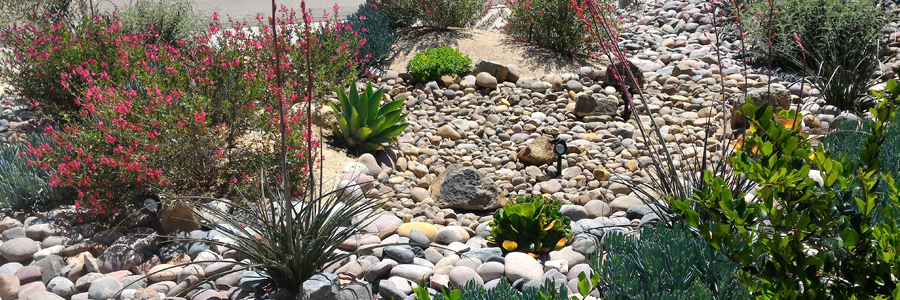
During these past years of severe drought, we’ve learned how to reduce outdoor water use by landscaping with drought-tolerant plants. We’ve discovered that native plants not only require less water, but are also visually pleasing when grouping plantings with contrasting colors and textures. With no end in sight to current drought conditions, landscapers are focusing more than ever on how to improve soil conditions that support plant health, using methods that encourage long-term sustainability, and that will help restore the environment. It’s known as Regenerative Landscapes or Landscaping.
Regenerative Landscaping goes beyond drought-resistant landscapes. While drought-resistant landscaping focuses on using less water but still keeping plants healthy during drought, Regenerative Landscapes think long term, using methods that improve soil conditions that are sustainable for future plantings, and that will play a major role in restoring our environment for years to come.
“It goes beyond water management, it’s a full capacity landscaping philosophy,” HydroPoint’s Training Manager Ben Coffey explains in Webinar, Regenerative Landscapes (Watch below!). “It’s more about focusing on healthy, natural landscaping that inevitably reduces water because it’s part of it– we plant the appropriate plants, and we take care of the soil.” Cielo Sichi, Landscape Architect for ReScape and Featured Speaker, recognizes an even broader audience beyond professional landscapers is now learning about the Regenerative Landscaping philosophy during recent webinar. “I call them Joe Public— the homeowners. They may not get the whole thing, but just getting education from landscaping companies like Gachina about this different approach is how word spreads. It’s so important that everybody’s on board. Just by choosing to use the right type of fertilizer, you’re helping.”
The 8 Principles of Regenerative Landscapes:
- Act Local
- Reduce Waste
- Nurture Soil
- Sequester Carbon
- Save Water
- Conserve Energy
- Protect Water * Air
- Create Habitat
“It’s a holistic approach to landscaping,” says Sichi. “At this point, sustainability is not quite enough. We can sustain, but given where we’re at, we really need to regenerate.” Through the process of photosynthesis, plants are continually absorbing carbon from the atmosphere, creating oxygen that is released back into the atmosphere—the air that we breathe. The top few feet of soil can store an incredible amount of carbon absorbed from the atmosphere. But soils can hold much more. Increasing organic matter in the top foot of soil by just one percent can remove one ton or more of carbon from the atmosphere. Because of this, Regenerative Landscaping has the potential of replacing tens of billions of tons of soil carbon lost to the atmosphere to maintain the balanced level of oxygen and carbon dioxide in our ecosystem.
Long-Term Benefits of Regenerative Landscaping:
- Biodiverse native plantings build and improve soil conditions, which enhances plant health and resilience against pests, disease and extreme climate conditions.
- Native, drought-tolerant plants require much less water, reducing runoff and soil erosion, which improves soil conditions for future plantings.
- Sustainable, drought-tolerant plants improve air quality by absorbing carbon dioxide from the atmosphere, and also provides a natural habitat for wildlife and honeybees, further improving the environment.
The most sustainable method of irrigation is drip irrigation, delivering water slowly at the ground surface and seeping down to nourish roots below the ground surface. Water waste from runoff, wind or evaporation are eliminated. Going even deeper, water left unused will move downward through soils until it reaches a layer of rock, fill the empty spaces and cracks, and become groundwater.
Smart watering goes hand in hand with sustainable landscape methods. Using patented technology to measure volumetric soil moisture deep in the root zone, Baseline’s Soil Moisture Sensors are capable of reading soil moisture changes of less than 0.1%, allowing for the best possible irrigation decisions from the irrigation controller when saving water.
Different plants and turf use different amounts of water under the same weather conditions. WeatherTRAK’s Custom Crop Coefficients scheduling engine can properly gauge daily water requirements and calculate depletion every day to create an optimized irrigation schedule for each individual station. It also helps meet mandatory water reduction goals.
“To meet a mandatory water reduction goal but not take the controller out of its automated, weather-based irrigation pattern, we do the math in our area and apply that specific percent reduction to the custom ET turf curve,” Chad Sutton, Gachina explains during webinar. “We’ve basically figured out the percentage to effectively make turf go dormant and save a ton of water at 35 to 40%.”

